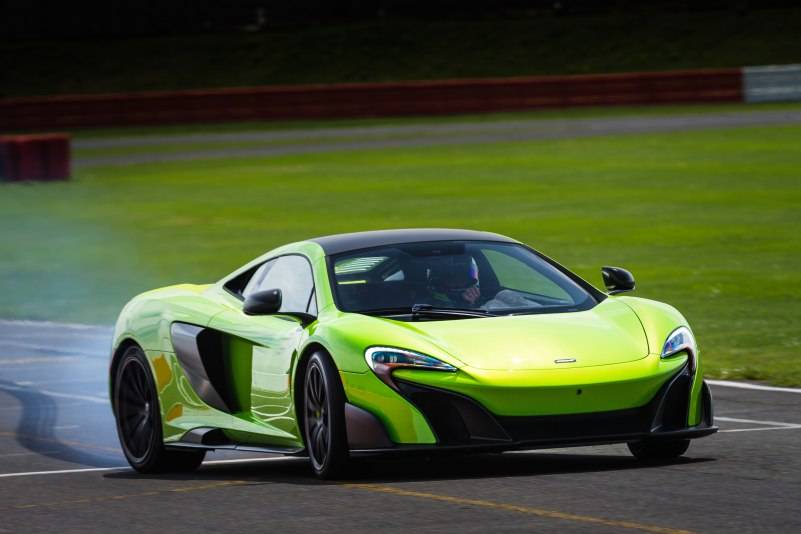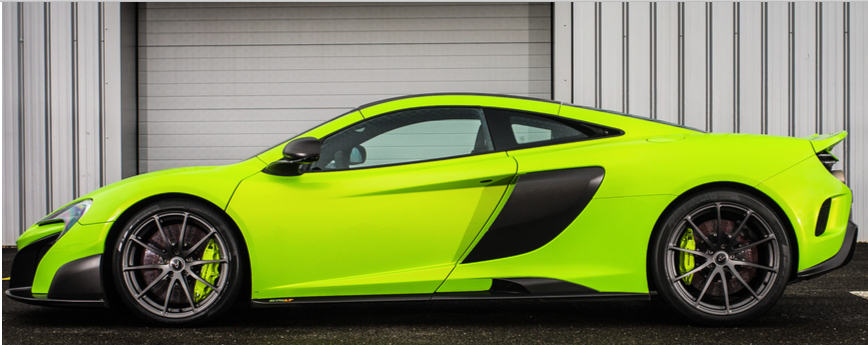McLaren 675LT Coupe

McLaren 675LT Coupe
“My” McLaren 675LT arrived liveried in Napier Green. Let me describe that color. It’s bright green, I mean REALLY bright green. Ten minutes after it arrived, I got a call from the International Space Station, asking me to cover it during the day. I must say that it’s a really interesting color, much like a George Barris creation of the 1960s, in that the green turns slightly yellow in bright sun, especially along the body creases. For the first time in my career as a journalist, I got a ticket while field-testing a car – it was for disturbing the peace – because the color was too loud. Paint point made.
The color gives the car the appearance that it’s as fast as it is. I mean, with 675 horsepower pumping out of a twin-turbo mid-engine V8 in a 2,712-pound car (that my friend is LIGHT), no one is surprised that 0-60 MPH is a tick over three seconds (it can go 0-60 and back to zero in the time that it takes to read this sentence) and what a thrilling three seconds it is, what with the old-school noise and drama and visceral feedback that this consummate driver’s car delivers. The transmission (McLaren calls it the SSG, a Seamless Shift Gearbox) is so smooth that in automatic mode (as if anyone ever would do that), it shifts before 2,000 RPM and the only feedback the driver receives is a change in the sound of the engine – no jerky shifts here. Yet on your way to the top speed of over 200 MPH, you’re likely to use the paddle shifters and be entertained by one of the best sounds ever to emanate from a man-made machine.

McLaren 675LT Coupe
The sound of the engine – faithful readers know my penchant for loud exhaust, no doubt a throwback to my years in the Gasoline Alley of my youth – is just awesome. In fact, that’s another example of how McLaren follows the credo of WYSIWYG (pronounced “WizzyWig” by the computer folks), as What You See definitely is What You Get – a road rocket that looks, sounds and behaves like the supercar which it appears to be.
This car makes no apologies for what it is either. Try the seats – a one-piece carbon fiber design that hugs your back and keeps your body in place. Want to adjust the back angle or the side supports? Get another seat. This bucket puts you where you’re meant to be if you are driving a supercar, slightly reclined instead of bolt-upright, with arms stretched straight in front (there is a front-back sliding adjustment) and held in place as protection against those pesky Gs which want to throw you around when this car is put through its paces.
So, now that you’ve read this far, let’s talk about the LT designation and what that means. It’s not as if every supercar company has a “long tail” version of their cars, right, so why does McLaren? The answer comes from history, back in the mid-1990s. Way back then, the McLaren racing team found that having a body with a short front (between the driver and the front bumper) but a long tail (between the driver and the rear bumper) gave it improved handling and a distinctive look. To many, the hottest car then on the planet was the McLaren F1. The vaunted McLaren F1 was the road-going version but, for racing, the McLaren F1 GTR actually had less power than the “regular” F1 due to racing restrictions at that time but, in its first racing outing – the 24 Hours of Le Mans in 1995 – the F1 GTRs finished first, third, fourth, fifth and thirteenth, an amazing victory (the first time a manufacturer had such results in its inaugural racing year) which cemented the McLaren name as a race car designer and builder in to the annals of history. Through those efforts, McLaren discovered that the longer tail (about two feet longer in their race cars) gave their cars less drag (wind resistance) and more downforce (increased pressure on the rear wheels, helping with traction). And that’s the genesis of the 675LT.

McLaren 675LT Coupe
McLaren currently makes several different models which belong to one of three groupings – the Sports Series (540C Coupe [not for sale in the U.S.] and 570S Coupe); the Super Series (650S Coupe, Spider and Can-Am Spider Limited Edition and the 675LT); and the Ultimate Series (the hypercars P1 and P1 GTR).
The U.S. models range in base price from about $185,000 to $150,000 (good luck getting a P1 or P1 GTR, though, as they were sold out faster than a ticket to a Beatles Reunion Tour – for our younger readers, that was Paul McCartney’s band before Wings).
McLaren’s pricing, starting with it’s first “mass-produced” car (the MP4-12C, sold 2011-2014) and continuing with the cars of today, generally puts its cars above the cost of supercars of similar performance. Call it a Panache Premium or an Exclusivity Excise as I found that whether I was parking the McLaren at the local Starbucks or at the monthly car shows which are prevalent in my hometown (Los Angeles), this car garnered far more attention than its competitors.
Faithful readers may recall my song of high praise for the 650S. Well, the 675LT is all that and then some. One might assume that, since it’s only “25 numbers” more than the 650S, the two cars are similar. They certainly do share some DNA but being a sibling doesn’t assure you of having your brother’s or sister’s abilities. (Note to my brother – this only was meant as a general comment.) I am told that some fifty percent of this car’s engine components are changed from the 650S’s, as are items like spring stiffness, the width of the wheel track and even the suspension tuning. I didn’t drive the two cars back to back but, based on my memory, although I really enjoyed the 650S, the 675LT is in a class by itself. To me, the 650S is a great sports car while the 675LT is a racecar for the street. It’s feather light, wields awesome power, is head-turning beautiful and it sounds totally badass. If there’s any criticism, it’s that the 675LT is so good that it will steal the thunder of the P1 – it’s that good. If you are considering this car, know that current plans call for only 500 coupes and 500 spiders and, as of this writing . . . they’re already all sold.


Sorry, the comment form is closed at this time.